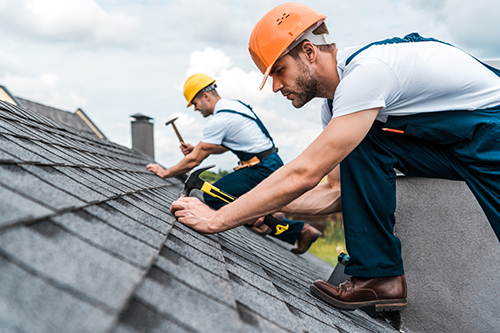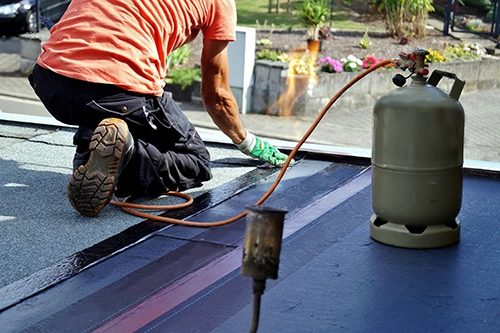- About Us
- Services
- Blog
- Contact
Need a quote?
Have you ever thought about how much energy you might be losing through your roof? Did you know that the services of a professional roofing company could save you huge amounts of money on your heating bill in the long run?
Today we’re here to talk about why you should consider repairing or replacing your roof as an investment in your future.




Energy is expensive and it’s only getting more so. If you’re looking for ways to cut down the cost of heating your home, then you should start with insulation. When most people think of insulating their homes, they often think of walls and windows, but, in many properties - particularly older properties - a startling amount of heat is actually lost through the roof.
A good roofing company will offer you a range of solutions from surveying the existing roof for damage, to making important repairs, to even replacing the roof with more modern and more durable materials.
In our opinion, a good roofing company is one with experience, expertise, and a wide range of energy-efficient roofing solutions. A professional roofing company can assess your current roof's condition and recommend the best materials, design, and insulation options for your home's specific needs and climate.
Additionally, they can ensure that your new roof is installed correctly and efficiently to maximise its energy-saving potential. By partnering with a trusted roofing company, you can make a smart investment in your home's energy efficiency and reap the benefits of major long-term savings.
While it can be a significant expense, in the long run, a new roof will provide numerous benefits, including better insulation and ventilation, reduced energy consumption, and improved indoor air quality. It will help to protect your loft from damp in the winter and with newer, more durable building materials, it should last for many years to come.
As with many home improvements, the sooner you do it, the more you’ll save. By replacing your roof, you’ll not only be cutting down your energy bill but helping the environment. A new roof is not only an investment in your future but, in a small way, it’s also an investment in the planet’s future.
It depends on the construction, but the minimum weight a flat roof must be capable of bearing is 300lbs. This refers to a concentrated weight where a load is positioned on just one area of the roof. So, for example, a commercial flat roof can approximately support a 300lb HVAC unit in a 2.5×2.5ft single space.
If you opt for a flat roof anywhere on your property, remember that it comes with a need for proper maintenance. Low-slope roofing London-wide should be checked every six months or so, or after spells of bad weather, to spot any signs of damage. No matter how small, these should be addressed before they escalate. Remove any debris (leaves, twigs and so on) regularly to avoid these blocking the gutters and allowing water to pool and stand on the roof.
If there are trees in the close vicinity, keep them cut back to reduce the amount of foliage that falls on your flat roof. And check internally for signs of moisture, dampness or water damage on a regular basis. Spotting problems early means resolving them will be cheaper in the long run.

Building a flat roof can be done in three ways. The simplest and most cost-effective choice for levelled roofing London-wide is to construct a warm roof where a roofing membrane is placed over the insulation that keeps the timber structure warm. Another option is to create a cold roof where insulation is positioned between the rafters under the ply roof covering. This is commonly applied to flat-roofed extensions.
The third method is the hybrid roof that contains diverse elements. Their designs require a gap of ventilation above a warm roof to prevent excess moisture within the roof structure.
If you’re looking for flat roofing local contractors, don’t just select the first firm you come across. Find a roofing company that’s been in business for a while and can demonstrate a good track record in installing, repairing, and replacing flat roofs specifically. Ask for recommendations from your own network or from a local trade association. If you need refurbishment work done to 50% or more of your roof, you’ll need a roofing contractor who can self-certify their work under the Competent Person Scheme. Otherwise, the Building Control department at your local authority will need to approve the job before it begins.
Ask whether they are covered by liability insurance and how long they’ll guarantee the work they will carry out. And never just opt for the cheapest quote unless you’re quite sure they’re the best company for the job. You can’t afford to compromise on your roof as the structural integrity of your property depends on it.
Ensuring your flat roof will comply with building regulations before installation can save property owners time, money and stress. First, the roof must have a slope of around 1:80, with water draining away to one or two roof edges. Waterproofing must be extended up to the adjacent walls with at least 150 mm from the surface of the roof.
Contractors must install ventilation in cold roofs. For warm roofs, the deck must be bonded with a VCL. The roof should have the capacity to withstand strong winds and be sturdy enough to take an individual’s weight. Finally, check whether planning permission is needed. Typically, this is only required if you live in a conservation area or a listed building, or are making significant changes to an existing roof.
If you’re looking for top roofing solutions at competitive rates, check out our range of roofing services at Environ Roofing Company London. To get started, call one of our representatives today!

